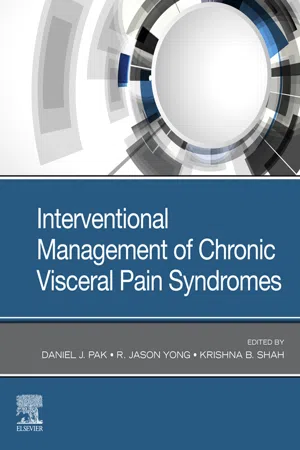Heena S. Ahmed, MD, Krishna B. Shah, MD, and Daniel J. Pak, MD
Introduction
Chronic visceral pain is estimated to affect over 20% of the global population, and it is one of the most common reasons why patients seek medical attention.1 More than 12 million physician visits each year in the United States are for abdominal pain, with functional gastrointestinal disorders, such as irritable bowel syndrome, representing the vast majority of these complaints.2,3 Globally, chronic female pelvic pain has been reported to affect up to 25% of reproductive-age women.4 In the outpatient setting, up to 47% of chest pain is categorized as noncardiac in nature.5
Additionally, chronic pain is widely prevalent in patients with visceral malignancies, with 52% of patients experiencing pain irrespective of disease stage and the percentage increasing to 71% in patients with advanced disease.6 Given the unpredictable and worsening nature of pain with disease progression, it is perhaps one of the most feared symptoms in patients battling cancer. Furthermore, with improved diagnostic tools and advancements in cancer treatment, there is a growing population of survivors who face the unexpected burden of treatment-related chronic pain syndromes, such as chemoradiotherapy-induced neuropathies and postsurgical pain.
Given its vague clinical presentation and potential concomitant factors, the diagnosis and management of visceral pain has a substantial economic impact. About 35%–41% of emergency visits for nonspecific abdominal pain are admitted to the hospital for further diagnostic evaluation.7,8 Chronic pancreatitis is estimated to cost the healthcare system approximately 150 million dollars in the United States annually.9 Chronic pelvic pain is the single most common indication for referral to women's health services, accounting for 20% of all outpatient appointments and resulting in $881.5 million spending per year in the United States alone.4 The economic impact for gastrointestinal disease is also high with an estimated $15–$20 billion a year in healthcare costs.10 Aside from the direct healthcare costs from chronic visceral pain, there is also a substantial economic impact from indirect costs associated with decreased productivity, lost workdays, and increased risk of long-term disability.1
Clinical Features and Neurotransmission
Visceral pain is characterized by diffuse and poorly localized pain due to low-density innervation of visceral structures relative to the sensory innervation of other tissues and divergence of the sensory inputs as they ascend in the peripheral and central nervous systems.1 Clinically, the mechanisms causing visceral pain vary widely and include distension of hollow organs, ischemia, traction on mesentery, muscular contractions of hollow organs, chemical irritants, and malignancies causing nerve compression among others.2,11 Visceral pain can involve the thoracic, abdominal, or pelvic organs and can also produce nonspecific motor, autonomic, and affective responses.1
Most viscera receive dual afferent innervation through sympathetic and parasympathetic nerves that ultimately project to the central nervous system. During a noxious event, the spinothalamic tract and dorsal column are the two major ascending fiber tracts in the spinal cord that convey sensory input from the viscera to the brain.12 Subsequent projections to the ventromedial thalamus are closely linked to the emotional and autonomic responses triggered by pain, while projections to the ventral posterolateral thalamus contribute to information related to pain perception, including location and intensity. Visceral pain also preferentially has increased activity in the anterior cingulate cortex, which may explain the strong emotional response to visceral pain.13 Furthermore, in response to persistent injury or inflammation, visceral afferents can lead to peripheral and central sensitization from increased neuron excitability. This leads to enhanced sensitivity as seen with hyperalgesia and an expanded area of referred pain as seen in some visceral pain syndromes such as irritable bowel syndrome, dyspepsia, and interstitial cystitis.11
Psychosocial Impact
The psychosocial impact of chronic visceral pain should be included as part of a comprehensive evaluation of the patient. As visceral afferent pathways have projections to the anterior cingulate cortex, there is a large emotional component of visceral pain that should be addressed in addition to the pain. Therefore, patients typically present with multiple vague and overlapping symptoms of visceral pain syndromes and concurrent mood disorders.
Visceral pain has a detrimental effect on quality of life.14 The emotional effects of pain varies from patient to patient and can lead to depression, anxiety, sleep disturbances, fatigue, decrease in physical and cognitive functioning, sexual dysfunction, and changes in mood and personality. It can also have a detrimental effect on relationships with family members and colleagues at work.1,15
Treatments
Due to the complexity and poor understanding of the mechanisms underlying many visceral pain syndromes, there are few treatment guidelines for providers to follow. Conservative management typically involves the use of nonopioid medications such as nonsteroidal antiinflammatory drugs, serotonergic agents, anticonvulsants, and acetaminophen among others.1 Although opioid therapy is commonly utilized for malignancy pain syndromes, its use for chronic nonmalignant visceral pain syndromes remains controversial and can be provided at the discretion of the provider. As previously mentioned, the psychosocial impact of chronic visceral pain syndromes cannot be understated and thus, behavioral therapy modalities should be utilized when appropriate. When conservative measures have been ineffective, treatment options aimed at the spinal afferent pathway including pain blocks or surgical interventions can be considered. A multidisciplinary approach is typically required for the treatment of these patients.
This book aims to provide a comprehensive approach for treating chronic visceral pain syndromes including a review of pharmacologic agents, psychotherapy, physical therapy, injections, and advanced interventions.
